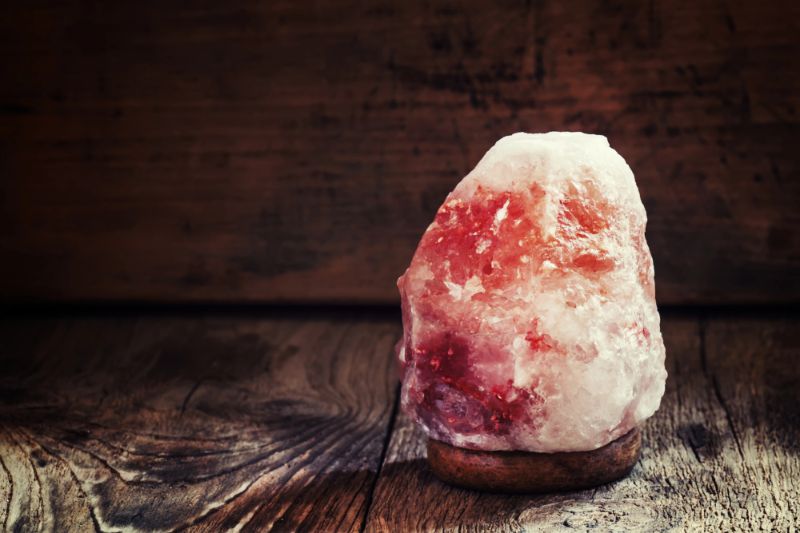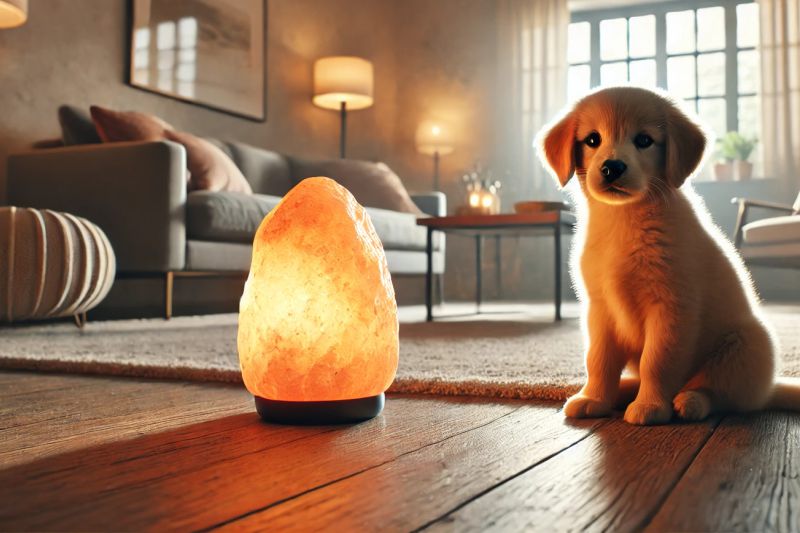Over recent years, pink Himalayan salt lamps have grown in popularity. This is largely down to their reported health benefits which include increased blood flow and improved sleep. They even supposedly help with allergies and breathing difficulties as well as helping with the ambience of a room. But whatever the benefits to your health, experts are now warning dog owners to beware of these lamps. Are Himalayan salt lamps dangerous for dogs? Is Himalayan salt bad for dogs? Let’s find out the answers below!
Are Himalayan salt lamps dangerous for dogs?
Too much of anything is rarely a good thing, and if our dogs consume too much salt, it can cause sodium poisoning, and Himalayan salt lamps are effectively giant lumps of salt. Salt toxicity occurs when pets ingest excessive amounts of salt, leading to serious health issues such as electrolyte imbalance.
To exacerbate the danger, Himalayan salt lamps are usually left in places that make them easily accessible, such as on the bedside cabinets, sofa tables, consoles and other places that our furry friends have no difficulty accessing.
What is salt toxicity?
Salt toxicity occurs when an animal ingests an excessive amount, leading to an imbalance of electrolytes in the body. This condition can range from mild to severe and can be life-threatening if not treated promptly.
Salt toxicity can occur when pets consume from various sources, including Himalayan salt lamps and high-salt foods. When a pet ingests too much, it disrupts their fluid balance, leading to a host of other health issues.
Owners must be aware of the potential dangers and take steps to prevent their furry friends from accessing these sources.
Common sources of salt toxicity
Salt toxicity can occur from various sources, and it’s essential to be aware of them to prevent this potentially fatal condition in dogs. Here are some common sources of salt toxicity in a dog:
- Human Food: Many human foods, especially salt-high snacks like potato chips, pretzels, and table foods with added salt, can be toxic to dogs. Even small amounts can cause toxicity, particularly in smaller breeds. It’s crucial to keep these snacks out of reach.
- Himalayan Salt Lamps: These popular decorative items can be a hidden danger. If a dog licks or ingests pink Himalayan salt, it can cause poisoning. The salt content in these lamps is high enough to cause serious health issues.
- Rock Salt: Often used as a de-icer, this can be toxic if ingested by dogs. Pets might ingest it while grooming their paws or licking surfaces where it has been applied. This can lead to salt toxicity and other health problems.
- Salt Lamps: Similar to Himalayan lamps, other types of salt lamps can also release salt particles into the air. Dogs that are prone to licking or chewing on surfaces might ingest these particles, leading to toxicity.
- Salty Foods: Foods high in salt, such as canned goods, processed meats, and other salty snacks, can be harmful to dogs if consumed in excess. These foods can disrupt the fluid and electrolyte balance in a dog’s body, leading to salt toxicity.
- Table Salt: Commonly known as sodium chloride, it can be toxic to dogs if consumed in large amounts. Dogs might consume it from various sources, including human food, salt shakers, or salt-based products.
- Salt Water: Salt water, whether from the ocean or a saltwater pool, can be toxic to a dog. Pets might drink some while swimming or playing, which can cause dehydration and electrolyte imbalances.
- Sodium Phosphate: Found in some household products like enema solutions and cleaning agents, it can be toxic to a dog if eaten. It’s important to keep these products out of reach.
- Homemade Playdough: Often made with salt, homemade playdough can be a hidden danger. Dogs might ingest play dough while playing or exploring, leading to toxicity.
- Paintballs: Surprisingly, paintballs contain salt and can be toxic if consumed by dogs. A dog might chew on or ingest paintballs while playing, which can result in serious health issues.
It’s essential to keep these sources of salt toxicity out of reach of your dog to prevent this potentially life-threatening condition. If you suspect your dog has ingested any of these sources, contact your vet immediately.
How pets can be exposed to Himalayan salt
Animals can be exposed to Himalayan salt through various means, which can dangerously elevate their sodium levels, and it’s important to recognise these potential hazards to keep them safe.
One common way is by licking or ingesting Himalayan salt lamps, which can release toxic amounts of sodium chloride.
Additionally, table salt, often found in kitchens, can be another source of toxic sodium chloride that pets might ingest. Pets might also consume foods like crisps or other high-salt snacks, which contain high amounts of sodium phosphate.
Even homemade ornaments or decorations made with Himalayan salt can pose a risk if your furbaby decides to chew on them.
Being mindful of these various sources can help prevent accidental salt poisoning in our furry friends!
The signs of salt poisoning in dogs
Recognising the signs early is crucial for effective treatment and prevention. Symptoms can vary depending on the amount and type of salt ingested, as well as the pet’s sensitivity. Common signs of salt poisoning include:
- Vomiting and diarrhoea
- Lethargy and appearing unusually tired or disinterested
- Increased thirst and urination as the body tries to expel excess salt
- Abnormal fluid balance, leading to dehydration and electrolyte imbalances
- Seizures
- Inability to walk properly
- Blindness
- Loss of appetite
If you notice any of these symptoms, it’s essential to seek veterinary care immediately. Some of these can escalate quickly, and early intervention is key to preventing severe health complications, including coma or death.
Tips for preventing sodium poisoning
To keep your dog safe, follow these precautions:
- Himalayan Salt Lamps: Keep these lamps as far from your pets as possible, or consider not having them in the house at all. Pets can easily access them and ingest dangerous levels of salt.
- Monitor Salt Intake: Pay attention to the foods your pets have access to. Salty snacks, processed meats, or table scraps with added salt can be harmful. Always store these foods out of reach.
- Prevent Access to Salt Water: Keep your pets from drinking salt water, whether at the beach or from saltwater pools, as it can lead to serious electrolyte imbalances.
- Safe Environment: Avoid leaving salt-based items, such as salt shakers, rock salt, or even homemade play dough, within reach of your pets. These can all be hidden dangers.
If your dog is showing any of the symptoms listed above and you suspect salt is the culprit, it’s crucial to get them to a vet as soon as possible. With swift care, many can recover from salt toxicity, but prevention remains the best strategy.
Treating Himalayan salt-related health issues
If you suspect that your pet has ingested Himalayan salt, licked a Himalayan salt lamp, or is showing signs of salt poisoning, it is essential to seek veterinary attention immediately.
Treatment for Himalayan salt lamp-related health issues may include inducing vomiting to remove the salt from the pet’s system and administering activated charcoal to absorb the salt.
Fluid therapy is often necessary to restore electrolyte balance and hydration, and monitoring blood sodium levels ensures they return to normal.
In severe cases, hospitalisation and intensive care may be required to manage symptoms and prevent complications. Prevention is the best way to avoid these health issues. Keep Himalayan salt lamps and other sources of salt out of reach of animals, and avoid feeding them salty foods or drinks.
If you have any concerns about your pet’s health or suspect that they have ingested Himalayan salt, consult with your vet for advice. Be sure to also check out our blog for more dog-related advice and safety tips!







